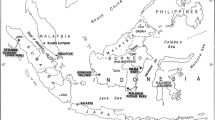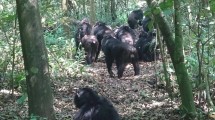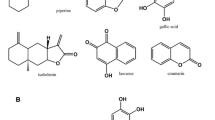Abstract
We previously reported on a study of 4 soils that chimpanzees of the Kanyawara community in the Kibale National Park, Uganda consumed on a near-daily basis. We suggested that iron was a possible chemical stimulus in association with high quantities of Si:Al = 1:1-dominated clay minerals in the consumed material. To test our initial findings, we analyzed 18 samples from the same general area including 7 samples that the chimpanzees did not eat. Among the chemical elements, As, Au, Br, Ca, Cl, Dy, Mg, Ni, Sb, Sr, and I are below detection limits. Only Fe stands out as a potentially important nutritional element present in sufficient quantity to provide a physiological stimulus for chimpanzees living at high elevations near the flanks of the Ruwenzori Mountains. Along with Fe, metahalloysite is present in high amounts in these soils. In its pure crystalline form as a pharmaceutical grade clay mineral metahalloysite may well counteract the debilitating effects of diarrhea, with an effect similar to what is achieved with kaolinite (cf. KaopectateTM). An unexpected result, the relatively high nitrogen and carbon in the eaten samples relative to the uneaten group, indicates the chimpanzees may have a higher threshold for organic-rich material than previously believed. Contrarily, the color of the ingested material, depicts a material with less humus than in the uneaten group, a finding that is compatible with previous work reported at other geophagy sites in Africa. Of all the choices of soil available to them, the chimpanzees appear to be selecting highly homogeneous chemical natural earths with well-leached and uniform mineralogical material similar to the uneaten group, but with higher relative amounts of clay size material.
Similar content being viewed by others
References
Aufreiter, S., Mahaney, W. C., Milner, M. W., Huffman, M. A., Hancock, R. G. V., Wink, M., Reich, M., and Sodhi, R. (2001). Mineralogical and chemical interactions of soils eaten by chimpanzees of the Mahale Mountains and Gombe Stream National Parks, Tanzania. J. Chem. Ecol. 27: 285–311.
Aufreiter, S., Hancock, R. G. V., Mahaney, W. C., Stambolic-Robb, A., and Sanmugadas, K. (1997). Geochemistry and mineralogy of soils eaten by humans. Int. J. Food Sci. Nutr. 48: 293–305.
Bennett, P. C., and Casey, W. (1994). Chemistry and mechanisms of low-temperature dissolution of silicates by organic acids. In Pittman E. D., and Lewan, M. D. (eds.), Organic Acids in Geological Processes. Springer-Verlag, pp. 162–200.
Birchall, J. D. (1994). Silicon-aluminum interactions and biology. In Bergna, H. E. (ed.), The Colloid Chemistry of Silica, Advances in Chemistry Series 234. American Chemical Society, Washington, DC.
Bolton, K. A., Campbell, V. M., and Burton, F. D. (1998). Chemical analysis of soils of Kowloon (Hong Kong) eaten by hybrid rhesus macacques. J. Chem. Ecol. 24: 195–205.
Brouillard, M.-Y., and Rateau, J.-G. (1989). Pouvoir d'asorption de deux argiles, la smectite et le kaolin sur des entérotoxines bactériennes. Gastroenterol. Clin. Biol. 13: 18–24.
Browman, D. L., and Gunderson, J. N. (1993). Altiplano comestible earths: Prehistoric and historic geophagy of highland Peru and Bolivia. Geoarchaeology8: 413–425.
Carlisle, E. M. (1975). Silicon. Nutr. Rev. 33: 257–261.
Carlisle, E. M. (1982). The nutritional essentiality of silicon. Nutr. Rev.40 (7): 193–198.
Christidis, G. E., and Kosiari, S. (2003). Decolorization of vegetable oils: A study of the mechanism of adsorption of β-carotene by an acid-activated bentonite from Cyprus. Clays Clay Miner. 51: 327–333.
Day, P. E. (1965). Particle fractionation and particle size analysis. In Black, C. A. (ed.), Methods of Soil Analysis, American Society of Agronomy, Madison, WI, pp. 545–567.
Dominy, N. J., Cavoust, E., and Minekus, M. (2004). Adaptive function of soil consumption: an in vitro study modelling the human stomach and small intestine. J. Exp. Biol.207: 319–324.
Food and Nutrition Board, Institute of Medicine (2001). Chromium. Dietary Reference Intakes for Vitamin A, Vitamin K, Boron, Chromium, Copper, Iodine, Iron, Manganese, Molybdenum, Nickel, Silicon, Vanadium, and Zinc, National Academy Press, Washington, DC, pp. 197–223.
Fossey, D. (1983). Gorillas in the Mist, Houghton Mifflin, London.
Ghiglieri, M. P. (1984). The Chimpanzees of Kibale Forest, Columbia University Press, New York.
Gilardi, J. D., Duffey, S. S., Munn, C. A., and Tell, L. A. (1999). Biochemical functions of geophagy in parrots: Detoxification of dietary toxins and cytoprotective effects. J. Chem. Ecol. 25: 897–922.
Gilardi, J. D. (1996). Ecology of Parrots in the Peruvian Amazon: Habitat Use, Nutrition and Geophagy, Ph.D. Thesis, University of California, 103 pp.
Hancock, R. G. V. (1984). On the source of clay used for Cologne Roman pottery. Archaeometry 26: 210–217.
Hui, Y. H. (1996). Baileys's Industrial Oil and Fat Products, 5th ed., Vols. 4 and 5, Edible Oil and Fat Products: Processing Technology, John Wiley & Sons, New York.
Hunter, J. M. (1973). Geophagy in Africa and in the United States: A Culture-Nutrition Hypothesis. Geograph. Rev. 63: 170–195.
Jackson, M. L. (1956). Soil Chemical Analysis-Advanced Course, published by the author, Dept. of Soil Science, University of Wisconsin, Madison, WI.
Jacobs, G. H., Deegan, J. F. II, and Moran, J. L. (1996). ERG measurements of the spectral sensitivity of common chimpanzee (Pan troglodytes). Vis. Res. 36: 2587–2594.
Johns, T. (1990). With Bitter Herbs They Shall Eat It: Chemical Ecology and the Origins of Human Diet and Medicine, University of Arizona Press, Tucson.
Jones, R. L., and Hanson, H. C. (1985). Mineral Licks, Geophagy, and Biogeochemistry of North American Ungulates, Iowa State University Press, Ames.
Jozefaciuk, G., and Bowanko, G. (2002). Effect of acid and alkali treatments on surface areas and adsorption energies of selected minerals. Clay Clay Miner. 50: 771–783.
Ketch, L., Malloch, D., Mahaney, W. C., and Huffman, M. A. (2001). Comparative microbial analysis and clay mineralogy of soils eaten by chimpanzees (Pan trogolodytes schweinfurthii) in Tanzania. Soil Biol. Biochem. 33: 199–203.
Koretsky, C. (2000). The significance of surface complexation reactions in hydrologic systems: a geochemist's perspective. J. Hydrol. 230: 127–171.
Krishnamani, R., and Mahaney, W. C. (2000). Geophagy among primates: Adaptive significance and ecological consequences. Anim. Behav.59: 899–915.
Laufer, B. (1930). Geophagy, Field Museum of Natural History, Anthropology Series, 18 (2), 97–198, Publication 280.
Mahaney, W. C. (1981). Paleoclimate reconstructed from paleosols: Evidence from East Africa and the Rocky Mountains. In. Mahaney, W. C. (ed.), Quaternary Paleoclimate. Geobooks, Norwich, UK, pp. 227–247.
Mahaney, W. C. (1990a). Glacially-crushed quartz grains in late Quaternary deposits in the Virunga Mountains, Rwanda - indicators of wind transport from the north. Boreas 19: 81–89.
Mahaney, W. C. (1990b). Ice on the Equator, Wm Caxton, Ellison Bay, WI, 386 pp.
Mahaney, W. C. (1993). Scanning electron microscopy of earth mined and eaten by mountain gorillas in the Virunga Mountains, Rwanda. Primates 34: 311–319.
Mahaney, W. C., and Krishnamani, R. (2003). Understanding geophagy in animals: standard procedures for sampling soils. J. Geochem. Ecol.29: 1503–1523.
Mahaney, W. C., Watts, D. P., and Hancock, R. G. V. (1990). Geophagia by mountain gorillas (Gorilla gorilla beringei in the Virunga Mountains, Rwanda. Primates 31: 113–120.
Mahaney, W. C., Hancock, R. G. V., and Inoue, M. (1993). Geochemistry and clay mineralogy of soils eaten by Japanese macaques. Primates 34: 85–91.
Mahaney, W. C., Stambolic, A., Knezevich, M., Hancock, R. G. V., Aufreiter, S., Sanmugadas, K., Kessler, M., and Grynpas, M. (1995a). Geophagy amongst Rhesus macaques on Cayo Santiago, Puerto Rico. Primates 36: 323–334.
Mahaney, W. C., Aufreiter, S., and Hancock, R. G. V. (1995b). Mountain gorilla geophagy: A possible seasonal behavior for dealing with the effects of dietary changes. Int. J. Primatol. 16: 475–488.
Mahaney, W. C., Hancock, R. G. V., Aufreiter, S., and Huffman, M. A. (1996). Geochemistry and clay mineralogy of termite mound soil and the role of geophagy in chimpanzees of the Mahale Mountains, Tanzania. Primates 37: 121–134.
Mahaney, W. C., Milner, M. W., Sanmugadas, K., Hancock, R. G. V., Aufreiter, S., Wrangham, R. W., Pier, H. W. (1997). Analysis of geophagy soils in Kibale Forest, Uganda.Primates 38: 159–176.
McLaren, A. D. (1975). Soils as a system of humus and clay immobilized enzymes. Chem. Script.8: 97–99.
McLaren, A. D., and Estermann, E. F. (1956). The adsorption and reactions of enzymes and proteins on kaolinite: III. The isolation of enzyme-substrate complexes. Arch. Biochem. Biophys. 61: 158.
Mertz, W. (1981). The essential trace elements. Science213: 1332–1338.
Oates, J. F. (1978). Water plant and soil consumption by guereza monkeys (Colobus guereza): a relationship with minerals and toxins in the diet? Biotropica 10: 241–253.
Oyama, M., and Takehara, H. (1970). Standard Soil Color Charts. Japan Research Council for Agriculture, Forestry and Fisheries.
Rufe, E., and Hochella, F., Jr. (1999). Quantitative assessment of reactive surface area of phlogopite during acid dissolution. Science 285: 874–876.
Said, S. A., Shibl, A. M., and Abdullah, M. E. (1980). Influence of various agents on adsorption capacity of kaolin for Pseudomonas aeruginosa toxin. J. Pharm. Sci. 69: 1238–1239.
Stambolic-Robb, A. (1997). Geophagy amongst free-ranging Sumatran orang-utans (Pongo pygmaeus abelii of Gunung Leuser National Park and ex-captive Bornean orang-utans (Pongo pygmaeus pygmaeus) of Sungai Wain Forest, Indonesia. MSc. Thesis, York University, Toronto, p. 143.
Stark, N. M., and Jordan, C. F. (1978). Nutrient retention by the root mat of an Amazonian rain forest. Ecology 59: 434–437.
Theng, B. K. G., and Orchard, V. A. (1995). Interactions of clays with microorganisms and bacterial survival in soil: A physicochemical perspective. In Huang, P. M., Berthelin, J., Bollag, J.-M., McGill, W. B., and Page, L. (eds.), Environmental Impact of Soil Component Interactions, CRC Press, Lewis Publishers, Boca Raton, FL.
Vermeer, D. E., and Ferrell, R. E., Jr. (1985). Nigerian geophagical clay: a traditional antidiarrheal pharmaceutical. Science 227: 634–636.
Wakibara, J. V., Huffman, M. A., Wink, M., Reich, S., Aufreiter, S., Hancock, R. G. V., Sodhi, R., Mahaney, W. C., and Russell, S. (2001). The adaptive significance of geophagy for Japanese Macaques (Macaca fuscata) at Arashiyama, Japan. Int. J. Primatol. 22: 495–520.
Whittig, L. D. (1965). X-ray diffraction techniques for numerical identification and mineralogical composition, In Black, C. A. (ed.), Methods of Soil Analysis, Madison, WI, American Society of Agronomy, pp. 671–696.
Wilson, M. J. (2003). Clay mineralogical and related characteristics of geophagic materials. J. Chem. Ecol. 29: 1525–1547.
Wink, M., Hofer, A., Bilfinger, M., Englert, E., Martin, M., and Schneider, D. (1993). Geese and plant dietary allelochemicals-food palatability and geophagy. Chemoecology 4: 93–107.
Wrangham, R. W., Chapman, C. A., Clark-Arcadi, A. P., and Isabirye-Basuta, G. (1996). Social ecology of Kanyawara chimpanzees; implications for understanding the costs of great ape groups. In McGrew, W. C., Marchant, L. F., and Nishida, T. (eds.), Great Ape Societies. Cambridge University Press, Cambridge, UK, pp. 45–57.
Author information
Authors and Affiliations
Corresponding author
Rights and permissions
About this article
Cite this article
Mahaney, W.C., Milner, M.W., Aufreiter, S. et al. Soils Consumed by Chimpanzees of the Kanyawara Community in the Kibale Forest, Uganda. Int J Primatol 26, 1375–1398 (2005). https://doi.org/10.1007/s10764-005-8857-7
Received:
Revised:
Accepted:
Issue Date:
DOI: https://doi.org/10.1007/s10764-005-8857-7




